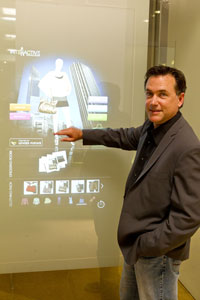
Touch-screen technology is about to move from consumers’ pockets to stores. Come the holiday season, you may be able to touch a glass storefront window at an apparel shop, mix and match clothes on a virtual mannequin and buy an outfit – all from the sidewalk.
United Future is in talks with major retailers and brands to bring this technology to stores in the next few months. The Culver City company is using touch-screen glass to introduce interactive storefronts that allows retailers to instantly change virtual displays and gives shoppers more control over purchases.
“What if you could actually have something in the window that you can change in every store around the country, right then,” said Scott Holmes, the company’s co-founder and president. “What we’ve done through this experience is enable all of those things to come together.”
Here’s how it works: Shoppers touch a glass screen, choose and drag virtual clothes onto a mannequin, pick an augmented reality background to display the clothes, adjust basic body type, decide what they like and buy it. Shoppers can use the technology to choose clothing and make purchases in department store windows or inside the store.
For retailers that sign on for the touch screens, which United Future plans to install at stores before the Christmas shopping season, the company will set up its glass, a layer of film that sticks to the glass, a projector and a powerful laptop for about $11,000.
“The relationship with the consumer is changing because the consumer expects more,” said Holmes, 47. “With more shopping going online, malls, retailers, physical locations, need to find new ways to attract and engage consumers at the retail level.”
The company was co-founded in 2005 by Holmes and Kris Matheney, the director of operations. The two previously worked together in digital marketing during the dot-com boom.
United Future is a subsidiary of digital advertising agency Wong Doody Crandall Wiener and shares its office space in Culver City. Secondary offices are in Seattle. United Future’s software was developed in an incubation department in the L.A. office.
The company, which has 28 full-time employees, projects revenue of $6 million to $8 million this year.
Wider use
United Future debuted its interactive touch-screen technology in November at the L.A. Auto Show in a wall display for Fullerton’s Yokohama Tire Corp., projecting live Twitter messages with pictures on a massive screen above the booth.
Airports in Minneapolis, Seattle and Portland, Ore., use the company’s technology in kiosks made by Santa Monica’s Digiboo, allowing people to purchase and download movies to watch in flight on their laptops in a rental service similar to Netflix.
T-Mobile USA Inc.’s New York concept store uses United Future’s technology to run its giant display.
United Future is working with the Sony Movie Channel to build out the network’s cloud film library services to create a digital locker for consumers.
The company also created ABC network’s early digital strategy, building episode recaps and clips of its television programs on Facebook.
United Future is now in talks with a major audio speaker company to develop its technology.
Each time a client signs on for services from the company, United Future has to develop a custom product. It doesn’t adapt one client’s product for another client.
“The experience has to be customized to the client,” Holmes said.
While he wouldn’t discuss individual contracts, the software runs anywhere from $5,000 to $500,000 per client, in addition to installment fees if clients choose to use the touch-screen technology.
Matheney believes that the return on investment retailers receive from the head-turning factor of their products, and the elimination of printing paper goods, makes those prices worth it.
“You’re going to save money printing cardboard for the things that hang in the window,” he said. “You’re going to increase the individual sales dollars at the register.”
Touching times
Alan Holtschneider, Yokohama’s manager of advertising, promotions and events said his company chose to work with United Future because the tire giant wanted to find a way to get consumers’ attention. He thinks United Future’s display did just that.
“It was like a fly catcher, basically,” Holtschneider said.
A downside of the touch-screen display is light.
“If it’s too bright, it won’t be as dynamic,” he said. “If that TV screen is in a really, really bright room, it won’t be as impactful.”
Alex Evans, vice president of LEK Consulting in Westwood, said that despite the technology’s appeal, it may not be an effective sales tool.
“One of the big open questions: Does it actually drive spending?” Evans asked. “That’s a bit of an unknown.”
Blake Thomas, Digiboo’s chief marketing officer, said his company uses United Future’s technology to monitor every movement a consumer makes on its touch-screen kiosks.
“The good thing about a digital storefront is you can make changes on the fly and respond to consumer demands,” Thomas said. “They got it about right the first time.”
